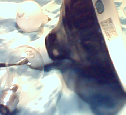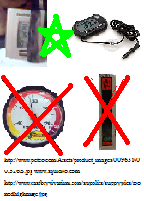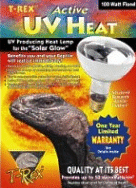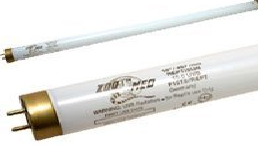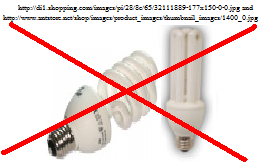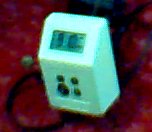Lighting
Bearded Dragons need their lights to mimic all the good things the sun gives them. These can be divided into 3 things; heat, UVA and UVB.
Heat and UVA - The Basking Light
The light that provides heat and some of the UVA (visible light) is called the basking light. The bright light of the basking light is needed for day-night cycles (12-14 hours on and 12-10 hours off) and to heat the surface of a basking spot to 100-110 degrees F. or 38 to 43 degrees C., the optimal temperature for a Bearded Dragon's digestion and necessary for their well-being.
Note on heat: young Bearded Dragons prefer 105-110 degrees F. or 40-43 C., while older prefer 100-105 F. or 38-40 C. That's for the surface of the basking spot. They should also have access to a cooler area across the tank from the basking spot, and this is called the "cool side". The cool side should be 70-85 degrees F. or 21-30 C. for all ages.
You can experiment with the wattages of the basking light till you find one that produces the correct temp gradient. Or you can get a dimmer so that you can use one wattage and adjust with the dimmer rather than switching the bulb out for a lower wattage one all the time. You can also adjust the height of the basking area to get the right temperature.
Bearded Dragons do best with a bright white light. In other words, they do poorly if they do not have this type of light. You can get bright white light with a typical household bulb. Most pet stores bulbs do not produce the correct color of light, nor are they generally as bright, so I do not recommend them. I also suggest getting clear household bulbs rather than the white bulbs, as the clear ones are usually brighter and their light is purer. Another good basking bulb you can use are Halogen floods, as these provide a whole lot of heat and a good spectrum of light.
|
Thermometers |
UVB and UVA - The UVB Light
UVB light is needed for your Bearded Dragon to synthesize vitamin D3. Vitamin D3, in turn, is needed to utilize calcium. Without UVB your Bearded Dragon can develop Metabolic Bone Disease (MBD), a nasty disease that involves the weakening of bones. Multiple fractures, breaks, paralyzing, handicaps, and a slow and painful death are some of the results. Other effects of not having a UVB light are lack of appetite, lethargy, and severe stunting of growth.
Note: Some believe that providing D3
in a lizard's diet prevents MBD. However, many studies have been done
on this and it has been found that D3 given orally does NOT prevent
MBD.
Bearded Dragons have particularly high UVB requirements, one of the highest of all captive lizards. For the pet owner, this means that you can purchase a UVB light at a pet store randomly and more likely than not it won't put out enough UVB to keep a Bearded Dragon healthy, although it may be enough to keep a different species of reptile healthy. It doesn't help matters that companies are legally allowed to put pictures of Bearded Dragons on the packaging of UVB lights that put out so little UVB that Bearded Dragons will develop Metabolic Bone Disease if that light is used as the only UVB source. In this section, I go over the different types of UVB lights and specifically name the brand and model of UVB bulbs that put out enough UVB to keep Bearded Dragons healthy.
There are three main types of UVB lights. They are Mercury Vapor Bulbs (MVBs), Fluorescent/Linear Tubes, and Compact/Coils. All of these types of UVB lights should be on for the same amount of time as the basking light.
|
Mercury Vapor Bulbs (MVBs) |
|
Fluorescent/Linear Tubes |
|
Compact/Coils |
Lighting Accesories
|
Light Timers |
|
Night Lights |
|
Dimmers |
